 W
WThe Agris Helmet is a ceremonial Celtic helmet from c. 350 BC that was found in a cave near Agris, Charente, France, in 1981. It is a masterpiece of Celtic art, and would probably have been used for display rather than worn in battle. The helmet consists of an iron cap completely covered with bands of bronze. The bronze is in turn covered with unusually pure gold leaf, with embedded coral decorations attached using silver rivets. One of the cheek guards was also found and has similar materials and designs. The helmet is mostly decorated in early Celtic patterns but there are later Celtic motifs and signs of Etruscan or Greek influence. The quality of the gold indicates that the helmet may well have been made locally in the Atlantic region.
 W
WThe Benty Grange helmet is a boar-crested Anglo-Saxon helmet from the 7th century AD. It was excavated by Thomas Bateman in 1848 from a tumulus at the Benty Grange farm in Monyash in western Derbyshire. The grave had probably been looted by the time of Bateman's excavation, but still contained other high-status objects suggestive of a richly furnished burial, such as the fragmentary remains of a hanging bowl. The helmet is displayed at Sheffield's Weston Park Museum, which purchased it from Bateman's estate in 1893.
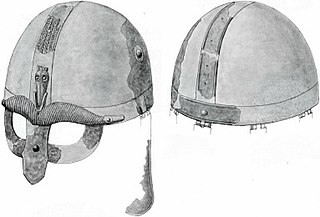 W
WThe Broe helmet is a decorated iron helmet from around the Vendel Period. Discovered around 1904 in a cremation grave in Broe, a farm on the Swedish island Gotland, it was located alongside other items including fragments of shields, weapons, bridles, and game pieces. Due to its extremely fragmented condition, only an incomplete reconstruction of the helmet is possible, but it appears to have been an example of the "crested helmets" that flourished in England and Scandinavia from the sixth through eleventh centuries.
 W
WThe Coppergate Helmet is an eighth-century Anglo-Saxon helmet found in York, England. It was discovered in May 1982 during excavations for the Jorvik Viking Centre at the bottom of a pit that is thought to have once been a well.
 W
WThe Coventry Sallet is a 15th-century helmet now on display at Herbert Art Gallery and Museum. English sallets have been considered both rare and important.
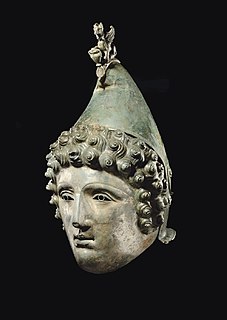 W
WThe Crosby Garrett Helmet is a copper alloy Roman cavalry helmet dating from the late 2nd or early 3rd century AD. It was found by an unnamed metal detectorist near Crosby Garrett in Cumbria, England, in May 2010. Later investigations found that a Romano-British farming settlement had occupied the site where the helmet was discovered, which was located a few miles away from a Roman road and a Roman army fort. It is possible that the owner of the helmet was a local inhabitant who had served with the Roman cavalry.
 W
WThe Emesa helmet is a Roman cavalry helmet from the early first century AD. It consists of an iron head piece and face mask, the latter of which is covered in a sheet of silver and presents the individualised portrait of a face, likely its owner. Decorations, some of which are gilded, adorn the head piece. Confiscated by Syrian police soon after looters discovered it amidst a complex of tombs in the modern-day city of Homs in 1936, eventually the helmet was restored thoroughly at the British Museum, and is now in the collection of the National Museum of Damascus. It has been exhibited internationally, although as of 2017, due to the Syrian civil war, the more valuable items owned by the National Museum are hidden in underground storage.
 W
WThe Gevninge helmet fragment is the dexter eyepiece of a helmet from the Viking Age or end of the Nordic Iron Age. It was found in 2000 during the excavation of a Viking farmstead in Gevninge, near Lejre, Denmark. The fragment is moulded from bronze and gilded, and consists of a stylised eyebrow with eyelashes above an oval opening. There are three holes at the top and bottom of the fragment to affix the eyepiece to a helmet. The fragment is significant as rare evidence of contemporaneous helmets, and also for its discovery in Gevninge, an outpost that is possibly connected to the Anglo-Saxon epic Beowulf. It has been in the collection of the Lejre Museum since its discovery, and has been exhibited internationally as part of a travelling exhibition on Vikings.
 W
WThe Gjermundbu helmet is a Viking Age helmet.
 W
WThe Guisborough Helmet is a Roman cavalry bronze helmet found in 1864 near Guisborough in the North Riding of Yorkshire, England. It was originally fitted with a pair of protective cheek-pieces, which have not survived; the holes by which they were attached can be seen in front of the helmet's ear guards. It is lavishly decorated with incised, punched and embossed figures, indicating that it was probably used for displays or cavalry tournaments, though it may well have been intended to be worn in battle as well. The helmet was found in what appears to have been a carefully arranged deposition in a bed of gravel, distant from any known Roman sites. After it was recovered during road works it was donated to the British Museum in London, where it was restored and is currently on display.
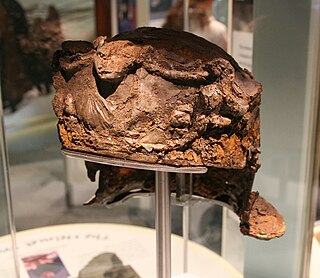 W
WThe Hallaton Helmet is a decorated iron Roman cavalry parade helmet originally covered in a sheet of silver and decorated in places with gold leaf. It was discovered in 2000 near Hallaton, Leicestershire after Ken Wallace, a member of the Hallaton Fieldwork Group, found coins in the area. Further investigation by professional archaeologists from the University of Leicester Archaeological Services discovered that the site appeared to have been used as a large-scale Iron Age shrine. Nine years of conservation and restoration have been undertaken by experts from the British Museum, supported by a Heritage Lottery Fund grant of £650,000. The helmet is now on permanent display at the Harborough Museum in Market Harborough alongside other artefacts from the Hallaton Treasure hoard.
 W
WThe Hellvi helmet eyebrow is a decorative eyebrow from a Vendel Period helmet. It comprises two fragments; the arch is made of iron decorated with strips of silver, and terminates in a bronze animal head that was cast on. The eyebrow was donated to the Statens historiska museum in November 1880 along with several other objects, all said to be from a grave find in Gotland, Sweden.
 W
WThe Helm of Cannae is an artefact in the antiquities collection of Franz, Count of Erbach-Erbach, at Erbach Palace in Erbach im Odenwald. It is, reputedly, one of the few surviving helmets from the field of the Battle between the Roman Republic and the Carthaginians under Hannibal in 216 BC. It is most famous for a legend about its acquisition by the count.
 W
WThe Helmet of Agighiol is a Getae silver helmet dating from the 4th century BC, housed in the National Museum of Romanian History, Bucharest.
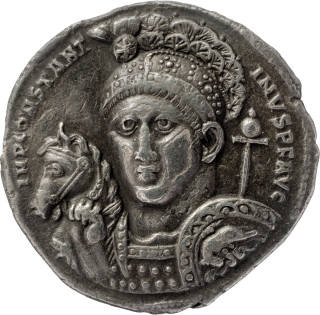 W
WThe Helmet of Constantine was a form of helmet worn by the Roman Emperor Constantine the Great, now lost, which featured in his imperial iconography. According to a story recorded by Ambrose and others, it included relics gathered in the Holy Land by his mother, Empress Helena. Constantine's conversion to Christianity, which happened around AD 300, was of great importance. In this period it was believed that touching the body of the deceased or even something that came in contact with the person who had died was said to have special powers. This belief started a movement to find these relics to protect churches, cities, and even people.
 W
WThe Golden Helmet of Coțofenești is a Geto-Dacian helmet dating from the first half of the 4th century BC.
 W
WThe Helmet of Iron Gates is a Geto-Dacian silver helmet dating from the 4th century BC, housed in the Detroit Institute of Arts, United States.
 W
WThe Helmet of Peretu is a Geto-Dacian silver helmet dating from the 4th century BC, housed in the National Museum of Romanian History, Bucharest. It comes from Peretu area, in the Teleorman County, Romania. There were 50 artifacts having 750g. The helmet is similar to the Helmet of Coţofeneşti and other three Getian gold or silver helmets discovered so far.
 W
WThe horned helmet of Henry VIII is the surviving part of a full suit of armour made by Konrad Seusenhofer between 1511 and 1514. The armour was a gift from Maximilian I, Holy Roman Emperor to the English king Henry VIII following their alliance in the War of the League of Cambrai. The suit was elaborate, intended for display at tournament parades. It is unclear who the armour was intended to be worn by but it appears to have been modelled on one of Henry's court fools. Henry may have worn the armour himself as a jest. The helmet has protruding eyes and a toothy grimace. It is adorned with horns and spectacles. The helmet survived when the rest of the suit of armour was scrapped, probably after the English Civil War, and is now in the collection of the Royal Armouries Museum in Leeds. The helmet is used as a symbol by the museum.
 W
WThe Lokrume helmet fragment is a decorated eyebrow piece from a Swedish helmet dating from the Viking Age. Discovered in Lokrume, a small settlement on the island of Gotland, it was first published in 1907 and is in the collection of the Gotland Museum. It is made of iron, the surface of which is decorated with silver and niello that forms an interlaced pattern.
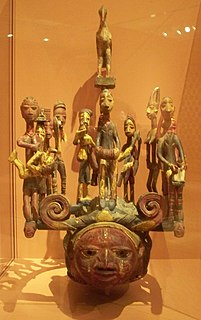 W
WThis Magbo helmet mask for an Oro society member was created by Yoruba artist Onabanjo of Itu Meko. It is currently located in the African collection of the Indianapolis Museum of Art, which is in Indianapolis, Indiana. Created around 1880-1910, it depicts a varied cast of community members carved of wood, colored with pigment, and mounted on a curved bar surmounting the helmet.
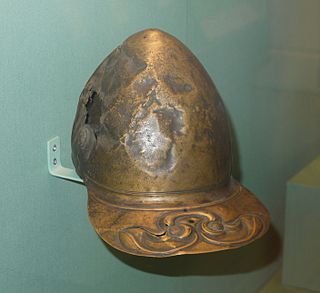 W
WThe Meyrick Helmet is an Iron Age bronze peaked helmet, with La Tène style decoration, that is held at the British Museum in London. It is one of only four Iron Age helmets to have been discovered in Britain, the other three being the more famous Waterloo Helmet, the Canterbury Helmet and the North Bersted Warrior helmet. Unlike the Waterloo Helmet, which bears two cone-shaped horns, the Meyrick Helmet is hornless and appears to be based on a Roman model. Vincent Megaw, emeritus professor of archaeology at the University of Leicester, has conjectured that the helmet may have belonged to a British auxiliary fighting in the Roman army during the campaigns against the Brigantes in AD 71–74.
 W
WThe Negau helmets are 26 bronze helmets dating to c. 450 BC–350 BC, found in 1812 in a cache in Ženjak, near Negau, Duchy of Styria. The helmets are of typical Etruscan 'vetulonic' shape, sometimes described as of the Negau type. It is not clear when they were buried, but they seem to have been left at the Ženjak site for ceremonial reasons. The village of Ženjak was of great interest to German archaeologists during the Nazi period and was briefly renamed Harigast during World War II. The site has never been excavated properly.
 W
WThe Newstead Helmet is an iron Roman cavalry helmet dating to 80–100 AD that was discovered at the site of a Roman fort in Newstead, near Melrose in Roxburghshire, Scotland in 1905. It is now part of the Newstead Collection at the National Museum in Edinburgh. The helmet would have been worn by auxiliary cavalrymen in cavalry displays known as hippika gymnasia. Its discoverer, Sir James Curle (1862–1944), described the helmet as "one of the most beautiful things that the receding tide of Roman conquest has left behind".
 W
WThe Nijmegen Helmet is a Roman cavalry sports helmet from the first or second century AD. It was found around 1915 in a gravel bed on the left bank of the Waal river, near the Dutch city of Nijmegen. The helmet would have been worn by the élite Roman cavalry. The head portion of the helmet is made of iron, while the mask and diadem are of bronze or brass. The helmet has a neck-protecting projecting rim, overlaid with a thin bronze covering plated with silver. The diadem features two male and three female figures.
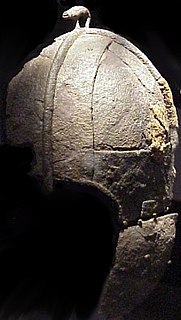 W
WThe Pioneer Helmet is a boar-crested Anglo-Saxon helmet from the late seventh century found in Wollaston, Northamptonshire, United Kingdom. It was discovered during a March 1997 excavation before the land was to be mined for gravel and was part of the grave of a young man. Other objects in the grave, such as a hanging bowl and a pattern welded sword, suggest that it was the burial mound of a high-status warrior.
 W
WThe Ribchester Helmet is a Roman bronze ceremonial helmet dating to between the late 1st and early 2nd centuries AD, which is now on display at the British Museum. It was found in Ribchester, Lancashire, England in 1796, as part of the Ribchester Hoard. The model of a sphinx that was believed to attach to the helmet was lost.
 W
WThe Shorwell helmet is an Anglo-Saxon helmet from the early to mid-sixth century AD found near Shorwell on the Isle of Wight in southern England. It was one of the grave goods of a high-status Anglo-Saxon warrior, and was found with other objects such as a pattern-welded sword and hanging bowl. One of only six known Anglo-Saxon helmets, alongside those from Benty Grange, Sutton Hoo, Coppergate, Wollaston, and Staffordshire, it is the sole example to derive from the continental Frankish style rather than the contemporaneous Northern "crested helmets" used in England and Scandinavia.
 W
WThe Staffordshire helmet is an Anglo-Saxon helmet discovered in 2009 as part of the Staffordshire Hoard. It is part of the largest discovery of contemporary gold and silver metalwork in Britain, which contained more than 4,000 precious fragments, approximately a third of which came from a single high-status helmet. Following those found at Benty Grange, Sutton Hoo, Coppergate, Wollaston, and Shorwell, it is only the sixth known Anglo-Saxon helmet.
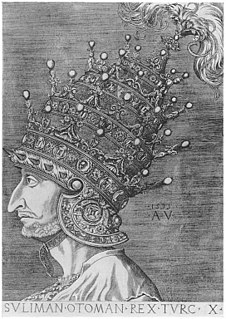 W
WSüleyman the Magnificent's Venetian helmet was an elaborate headpiece designed to project the sultan's power in the context of the Ottoman–Habsburg rivalry. It was acquired by the sultan in 1532. The rivalry with the Habsburg Monarchy was one of the most significant political and military relationships addressed by the sultan during his reign. In addition to military campaigns, Süleyman also took political and diplomatic steps in order to advance the Ottoman position, promoting trade with European powers and purchasing expensive jewels such as the helmet. The key figures behind the purchase of the helmet were Grand Vizier Ibrahim Pasha and his chief advisors, İskender Çelebi, the chief treasurer, and Alvise Gritti, a powerful jewellery merchant based in the Ottoman capital Konstantinyye, or Istanbul, as it was renamed in 1930.
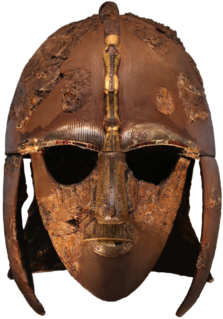 W
WThe Sutton Hoo helmet is an ornately decorated Anglo-Saxon helmet found during a 1939 excavation of the Sutton Hoo ship-burial. It was buried around 625 and is widely associated with King Rædwald of East Anglia; its elaborate decoration may have given it a secondary function akin to a crown. The helmet was both a functional piece of armour that would have offered considerable protection if ever used in warfare, and a decorative, prestigious piece of extravagant metalwork. It is described as "the most iconic object" from "one of the most spectacular archaeological discoveries ever made", and perhaps the most important known Anglo-Saxon artefact.
 W
WThe Tjele helmet fragment is a Viking Age fragment of iron and bronze, originally comprising the eyebrows and noseguard of a helmet. It was discovered in 1850 with a large assortment of smith's tools in Denmark, and though the find was sent to the National Museum of Denmark, for 134 years the fragment was mistaken for a saddle mount. In 1984 it was properly identified by an assistant keeper at the museum as the remainder of one of only five known helmets from the Viking era.
 W
WThe Waterloo Helmet is a pre-Roman Celtic bronze ceremonial horned helmet with repoussé decoration in the La Tène style, dating to circa 150–50 BC, that was found in 1868 in the River Thames by Waterloo Bridge in London, England. It is now on display at the British Museum in London.
 W
WThe Witcham Gravel helmet is a Roman auxiliary cavalry helmet from the first century AD. Only the decorative copper alloy casing remains; an iron core originally fit under the casing, but has now corroded away. The cap, neck guard, and cheek guards were originally tinned, giving the appearance of a silver helmet encircled by a gold band. The helmet's distinctive feature is the presence of three hollow bosses, out of an original six, that decorate the exterior. No other Roman helmet is known to have such a feature. They may be a decorative embellishment influenced by Etruscan helmets from the sixth century BC, which had similar, lead-filled bosses, that would have deflected blades.